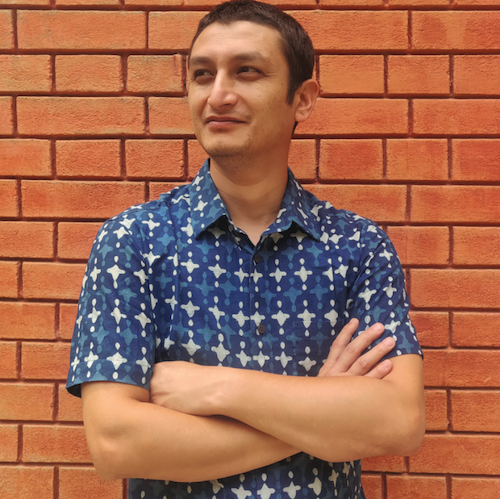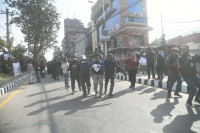Opinion
Bending the knee
If we continue to imagine our culture as unchanging, we will remain entombed in imagined hierarchies
Amish Raj Mulmi
We were out for dinner during Indra Jatra when we began to discuss the role of tradition in the 21st century. A few days previously, on a Monday, a friend had walked through Basantapur in the evening, just as the working day was coming to an end. The durbar square was so crowded, he said, with the jatra revellers that he had to abandon any hopes of walking across it. The night of the dinner, the square was equally crowded, chimed in another. Coming from Pokhara, where Indra Jatra isn’t really a thing, it was a revelation. How did the crowds manage to turn up day in and day out during a working week, I wondered.
“It’s tradition,” the friend said. I couldn’t make out if he was being sardonic or serious. But my response was, “How do people—young people at that—have so much time on their hands?” Was the draw of the tradition so strong, the culture so imbibed that the youth left their workplaces earlier than usual to participate in the jatra? Or was it something more than that?
There is no doubt that Nepal’s old traditions and cultures are still alive and vibrant, but every once in a while I begin to think about the dynamic times we live in, the globalised nature of our world, and the place of tradition in it. Can there be balance between tradition and modernity? Is one compatible with the other? Or does tradition need to evolve to keep in pace with modern times?
The now-famous Dashain visual of President Bidya Bhandari offering tika to various government functionaries, and the criticism of the almost-servile government functionaries bending low to receive tika brought back memories of that dinner. That it came during the week the Supreme Court of India removed the restrictions on women entering the famous Ayyappa temple in Kerala, and the subsequent protests against the decision made it even more serendipitous. To dismiss the outcry over them as unnecessary politicisation of a religious and traditional affair would be short-sighted; together, they are an affirmation of how deep religion has permeated into our states, and how our outlook is still determined by our traditions.
Culture versus modernity: it remains an eternal battle. In Simikot, during the annual Deudaha festival, an old man emphatically tried to impress upon me the festival’s importance. “This is part of our culture, part of Hindu culture. We cannot let it die,” he had said. From the numerous young people who had come to participate, it was clear that the festival wouldn’t die anytime soon. Part of the reason could be that the festival was rooted in romance: young men and women sang to each other songs laden with innuendo, in what was a traditional courtship ritual. But Deudaha had evolved. The number of days people danced had decreased, and it had also evolved into a space where raunchier songs could be sung (out of the earshot of elders).
Traditions, cultures, rituals—all these are spaces that negotiate the zeitgeist. But when they come up against the individualised 21st century worldview, these communal ideals face an uphill task. At the same time, the assumption that traditions must continue the way they were practiced a century ago is flogging a dead horse. Cultures and societies evolve, and so must tradition. To argue otherwise is futile: change is the only constant through history.
Religion and the state
In The Souls of China, journalist Ian Johnson traces the story of three different families in modern China over the course of a year. He showcases the respective families’ religious beliefs and practices, and argues that despite Mao’s Cultural Revolution—which attacked the ‘Four Olds’ of ideas, customs, culture and habits—religion had never fully been wiped out in China, and is in fact making a comeback by providing spiritual answers in a material world. But in a society like China, where the ruling party holds extraordinary power, even religion is guided to suit the needs of the state.
Johnson’s revealing book is an extraordinary story of faith and tradition in China under Xi Jinping, who ‘made fixing China’s moral malaise his top priority’. Confucianism, the ancient Chinese philosophy, was promoted as an ‘instant, made-in-China value system’ that the Communist Party co-opted to emphasise ‘hierarchy and obligation to those above’. In essence, the Party realised it could push a version of faith and religion that kept its grip on power while allowing its citizens to feel spiritually nourished in a time of extraordinary material gains. In China, religion had never required a priestly class, it had ‘always been run by ordinary people’, and expressed through daily routines. As such, it offered an individualised form of belief that rarely grounds itself in fixed traditions.
Our traditions, on the other hand, are behoven to a hierarchy as has been supposedly advised by our shastras. Hinduism, by its very nature, succumbs to divisions created through varna and jaati, even as it finds new ways to cling to power. And as much as we’d like to deny it, the divisions created by caste and ethnicity are embedded in our society, and subsequently, our state. This is not unique to Nepal. In India, too, a woman minister argued against the Supreme Court order allowing women to worship at the Kerala temple. Such self-imposed hierarchies, such narrowness of thought are part of our civilizational make-up. ‘Learn our place,’ we have been told over and over. Of course we will come to believe in the immutability of tradition and culture.
The Dashain visual is symptomatic of such a culture. The status quo has been challenged several times over the years in Nepal, but its roots are dug in so deep that despite two people’s revolutions, one people’s war and the end of a Hindu monarchy, we are at least a generation away from uprooting it completely. ‘Rulers will continue to make slaves out of the subservient until they continue to believe they are horses,’ a Kantipur editorial lashed out at the Dashain tika ceremony that reminded one of the monarchy’s heydays. One had no reason to disagree.
Religion and the individual
One is not rejecting culture and heritage by arguing against religion’s trappings. If anything, culture goes far beyond religion: our foods, for instance, are an anthropologist’s dream come true. But if we continue to imagine our culture and tradition as a monolithic, unchanging and unyielding ideal, we will remain entombed in the bubble of imagined hierarchies as devised by those who hold religious authority. “Fatalism comes out of Hindu Puranic texts,” declared anthropologist Dor Bahadur Bista. I’d think there’s very little reason to counter this. And yet, several years later, we continue to see mahayagnas being held for no whatsoever reason, government functionaries behaving as if they are beholden to higher powers, and any idea that goes against traditional thought countered as an assault on culture and religion.
In an era of politics polarised around identities, societies will coalesce around ideals they declare their own. They will also counter the rise of ideals inimical to their status quo. After all, self-preservation is a natural instinct. And there’s no better weapon in the armory of status quoists than invoking tradition and culture against those seeking a more enlightened society. A consumerist world will inevitably offer little succour to those who want more than just material gains, but clinging to religion and its fictional hierarchies is no answer.
Post-script: As reminiscent of monarchic Nepal as the Dashain picture was, it was also an impressive expression of the inversion of power, with Khas men bending their knee to a woman, a much-needed respite amid times of all-male representation in positions of power. As far as symbols go, it’s a powerful one, but in reality, there’s much that remains to be done.




 8.12°C Kathmandu
8.12°C Kathmandu










